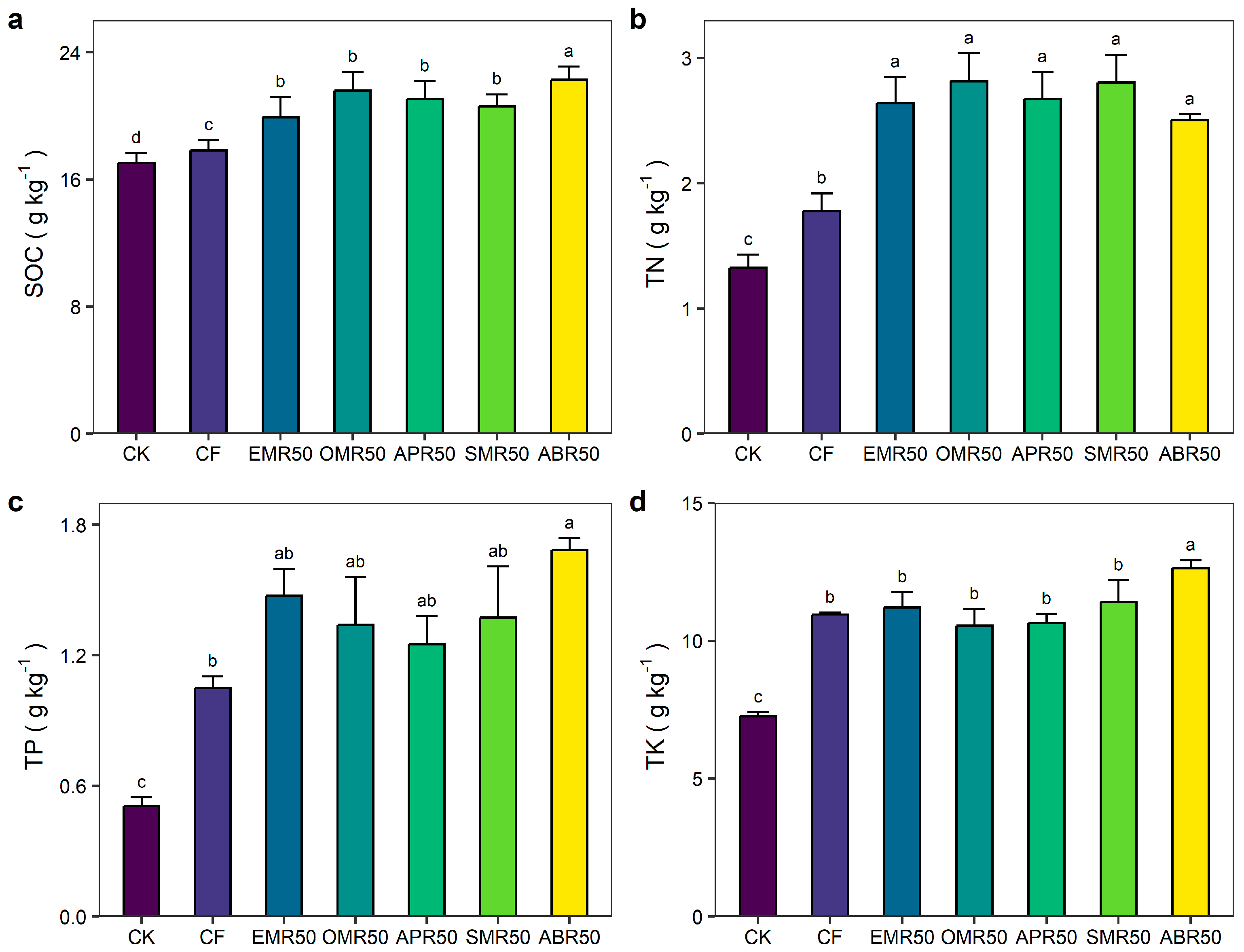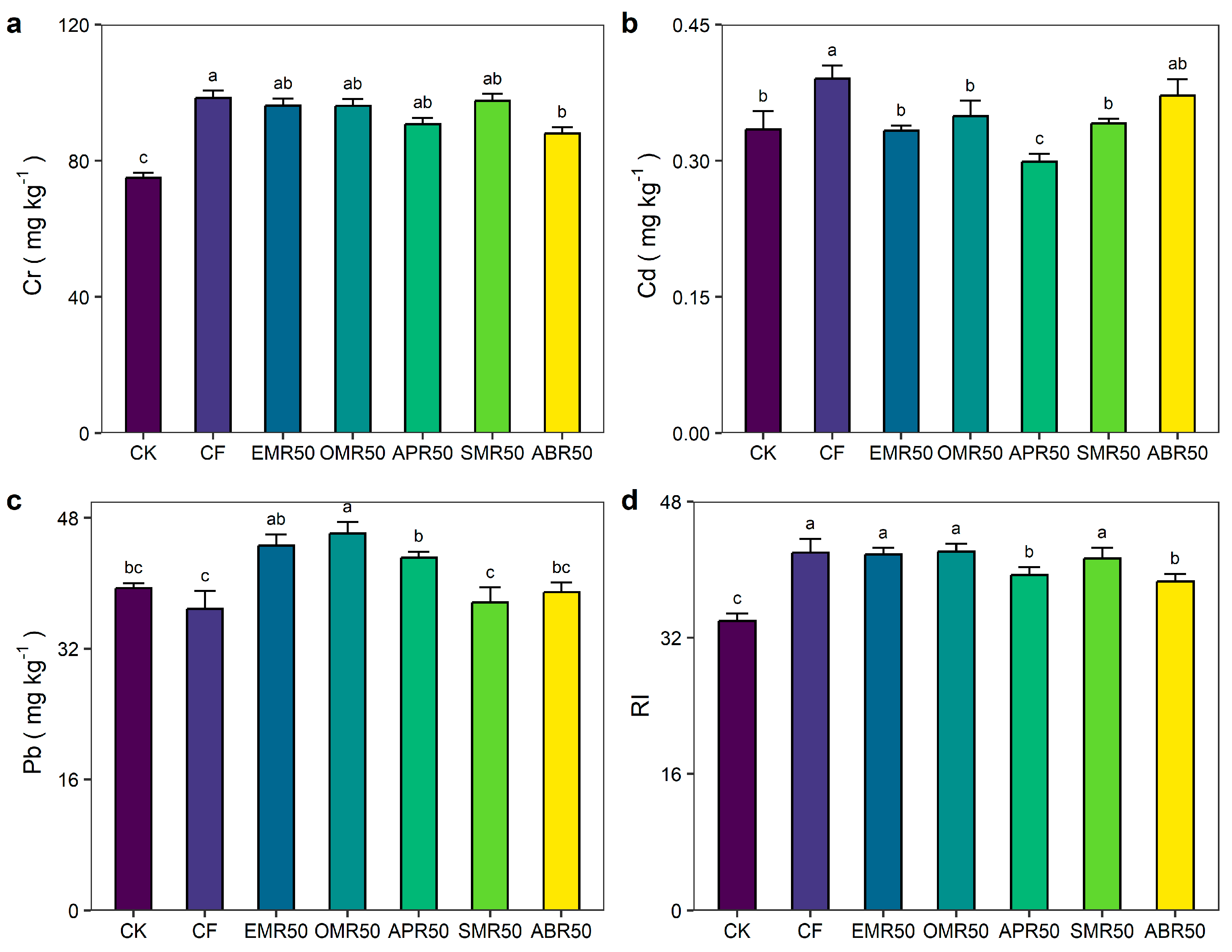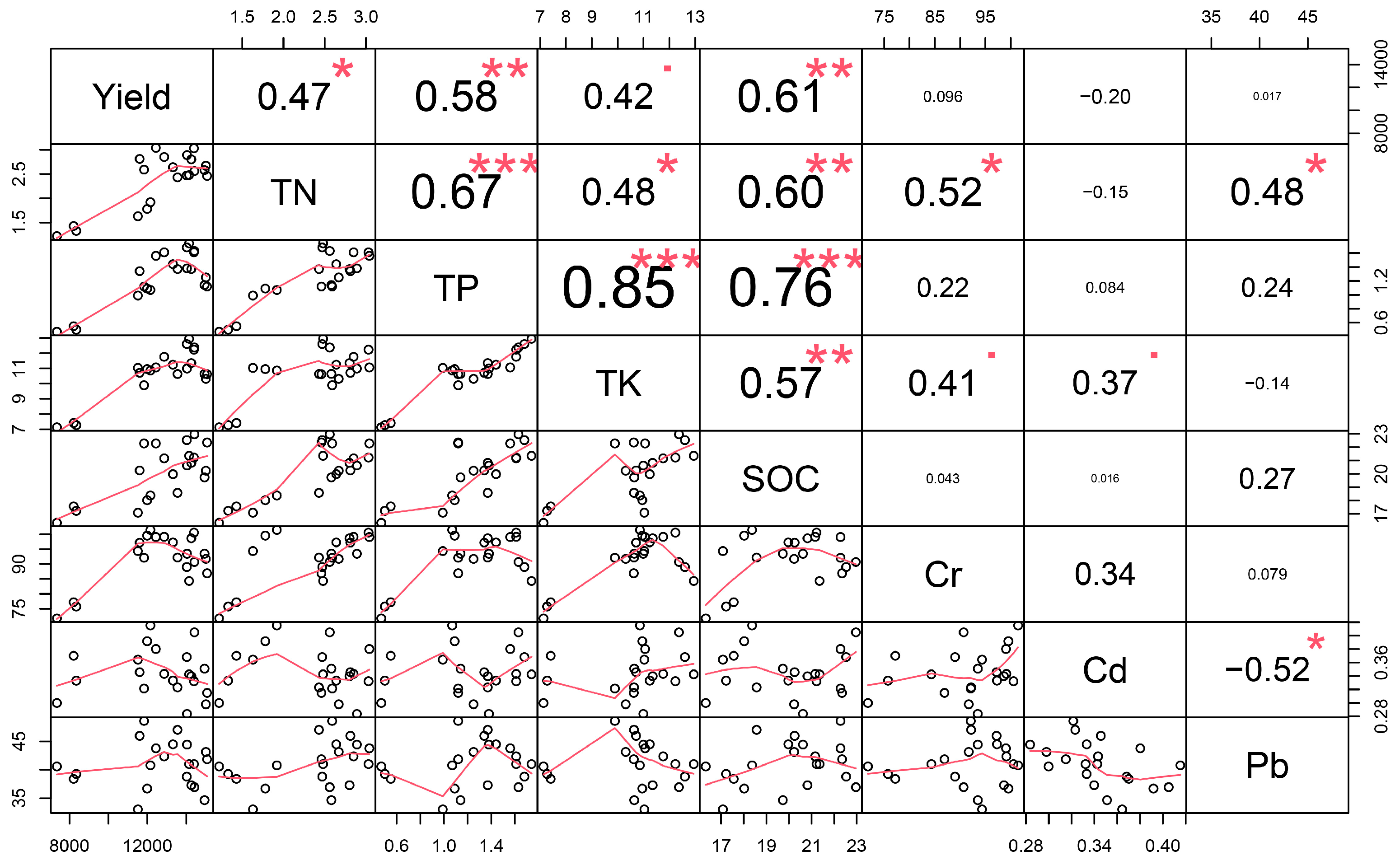Responses of Crop Yield, Soil Fertility, and Heavy Metals to Spent Mushroom Residues Application
Abstract
1. Introduction
2. Results
2.1. Crop Yield and Soil Fertility
2.2. Heavy Metals
2.3. Relationships between Soil Nutrients and Crop Yield and Heavy Metals
3. Discussion
3.1. Response of Crop Yield and Soil Nutrients to Fertilization
3.2. Response of Heavy Metals to Organic and Chemical-Organic Fertilization
4. Materials and Methods
4.1. Experiment Aera
4.2. Experimental Design
4.3. Soil Sampling and Analysis
4.4. Data Analysis and Statistics
5. Conclusions
Author Contributions
Funding
Data Availability Statement
Acknowledgments
Conflicts of Interest
References
- Tan, F.; Hou, Y.; Huang, X.; Jia, J.; Yang, H.; Luo, P. Temporal and Spatial Arrangement of Wheat Sowing Date: A Revolutionary Strategy to Accomplish Tianfu Granary. Front. Plant Sci. 2023, 14, 1240417. [Google Scholar] [CrossRef]
- Shao, Z.; Chen, C.; Liu, Y.; Cao, J.; Liao, G.; Lin, Z. Impact of Land Use Change on Carbon Storage Based on FLUS-InVEST Model: A Case Study of Chengdu–Chongqing Urban Agglomeration, China. Land 2023, 12, 1531. [Google Scholar] [CrossRef]
- Zhang, D.; Dong, H. Understanding Arable Land Change Patterns and Driving Forces in Major Grain-Producing Areas: A Case Study of Sichuan Province Using the PLUS Model. Land 2023, 12, 1443. [Google Scholar] [CrossRef]
- Zheng, J.; Chi, Z.; Jiang, X.; Tang, Y.; Zhang, H. Experiences and Research Perspectives on Sustainable Development of Rice-Wheat Cropping Systems in the Chengdu Plain, China. Agric. Sci. China 2010, 9, 1317–1325. [Google Scholar] [CrossRef]
- Wang, Y.; Liang, B.; Bao, H.; Chen, Q.; Cao, Y.; He, Y.; Li, L. Potential of Crop Straw Incorporation for Replacing Chemical Fertilizer and Reducing Nutrient Loss in Sichuan Province, China. Environ. Pollut. 2023, 320, 121034. [Google Scholar] [CrossRef] [PubMed]
- Li, Q.; Li, A.; Yu, X.; Dai, T.; Peng, Y.; Yuan, D.; Zhao, B.; Tao, Q.; Wang, C.; Li, B.; et al. Soil Acidification of the Soil Profile across Chengdu Plain of China from the 1980s to 2010s. Sci. Total Environ. 2020, 698, 134320. [Google Scholar] [CrossRef] [PubMed]
- Shu, X.; He, J.; Zhou, Z.; Xia, L.; Hu, Y.; Zhang, Y.; Zhang, Y.; Luo, Y.; Chu, H.; Liu, W.; et al. Organic Amendments Enhance Soil Microbial Diversity, Microbial Functionality and Crop Yields: A Meta-Analysis. Sci. Total Environ. 2022, 829, 154627. [Google Scholar] [CrossRef] [PubMed]
- Xia, L.; Lam, S.K.; Chen, D.; Wang, J.; Tang, Q.; Yan, X. Can Knowledge-based N Management Produce More Staple Grain with Lower Greenhouse Gas Emission and Reactive Nitrogen Pollution? A Meta-analysis. Glob. Chang. Biol. 2017, 23, 1917–1925. [Google Scholar] [CrossRef] [PubMed]
- Smith, L.E.D.; Siciliano, G. A Comprehensive Review of Constraints to Improved Management of Fertilizers in China and Mitigation of Diffuse Water Pollution from Agriculture. Agric. Ecosyst. Environ. 2015, 209, 15–25. [Google Scholar] [CrossRef]
- Liu, L.; Zheng, X.; Wei, X.; Kai, Z.; Xu, Y. Excessive Application of Chemical Fertilizer and Organophosphorus Pesticides Induced Total Phosphorus Loss from Planting Causing Surface Water Eutrophication. Sci. Rep. 2021, 11, 23015. [Google Scholar] [CrossRef] [PubMed]
- Liu, T.; Wu, G. Does Agricultural Cooperative Membership Help Reduce the Overuse of Chemical Fertilizers and Pesticides? Evidence from Rural China. Environ. Sci. Pollut. Res. 2022, 29, 7972–7983. [Google Scholar] [CrossRef] [PubMed]
- He, R.; Shao, C.; Shi, R.; Zhang, Z.; Zhao, R. Development Trend and Driving Factors of Agricultural Chemical Fertilizer Efficiency in China. Sustainability 2020, 12, 4607. [Google Scholar] [CrossRef]
- Zhuang, M.; Zhang, J.; Kong, Z.; Fleming, R.M.; Zhang, C.; Zhang, Z. Potential Environmental Benefits of Substituting Nitrogen and Phosphorus Fertilizer with Usable Crop Straw in China during 2000–2017. J. Clean. Prod. 2020, 267, 122125. [Google Scholar] [CrossRef]
- Gao, Y.; Wu, Z.; Li, W.; Sun, H.; Chai, Y.; Li, T.; Liu, C.; Gong, X.; Liang, Y.; Qin, P. Expanding the Valorization of Waste Mushroom Substrates in Agricultural Production: Progress and Challenges. Environ. Sci. Pollut. Res. 2023, 30, 2355–2373. [Google Scholar] [CrossRef] [PubMed]
- Mohd Hanafi, F.H.; Rezania, S.; Mat Taib, S.; Md Din, M.F.; Yamauchi, M.; Sakamoto, M.; Hara, H.; Park, J.; Ebrahimi, S.S. Environmentally Sustainable Applications of Agro-Based Spent Mushroom Substrate (SMS): An Overview. J. Mater. Cycles Waste Manag. 2018, 20, 1383–1396. [Google Scholar] [CrossRef]
- Leong, Y.K.; Ma, T.-W.; Chang, J.-S.; Yang, F.-C. Recent Advances and Future Directions on the Valorization of Spent Mushroom Substrate (SMS): A Review. Bioresour. Technol. 2022, 344, 126157. [Google Scholar] [CrossRef]
- Baptista, F.; Almeida, M.; Paié-Ribeiro, J.; Barros, A.N.; Rodrigues, M. Unlocking the Potential of Spent Mushroom Substrate (SMS) for Enhanced Agricultural Sustainability: From Environmental Benefits to Poultry Nutrition. Life 2023, 13, 1948. [Google Scholar] [CrossRef]
- Paula, F.S.; Tatti, E.; Abram, F.; Wilson, J.; O’Flaherty, V. Stabilisation of Spent Mushroom Substrate for Application as a Plant Growth-Promoting Organic Amendment. J. Environ. Manag. 2017, 196, 476–486. [Google Scholar] [CrossRef]
- Huang, C.; Han, X.; Luo, Q.; Nie, Y.; Kang, M.; Chen, Y.; Tang, M.; Fu, Y.; Li, X.; Chen, Y. Agro-Based Spent Mushroom Compost Substrates Improve Soil Properties and Microbial Diversity in Greenhouse Tomatoes. Agronomy 2023, 13, 2291. [Google Scholar] [CrossRef]
- Alves, L.D.S.; Caitano, C.E.C.; Ferrari, S.; Vieira Júnior, W.G.; Heinrichs, R.; De Almeida Moreira, B.R.; Pardo-Giménez, A.; Zied, D.C. Application of Spent Sun Mushroom Substrate in Substitution of Synthetic Fertilizers at Maize Topdressing. Agronomy 2022, 12, 2884. [Google Scholar] [CrossRef]
- Li, F.; Kong, Q.; Zhang, Q.; Wang, H.; Wang, L.; Luo, T. Spent Mushroom Substrates Affect Soil Humus Composition, Microbial Biomass and Functional Diversity in Paddy Fields. Appl. Soil Ecol. 2020, 149, 103489. [Google Scholar] [CrossRef]
- Herrero-Hernández, E.; Andrades, M.S.; Villalba Eguren, G.; Sánchez-Martín, M.J.; Rodríguez-Cruz, M.S.; Marín-Benito, J.M. Organic Amendment for the Recovery of Vineyard Soils: Effects of a Single Application on Soil Properties over Two Years. Processes 2022, 10, 317. [Google Scholar] [CrossRef]
- Chen, L.; Zhou, W.; Luo, L.; Li, Y.; Chen, Z.; Gu, Y.; Chen, Q.; Deng, O.; Xu, X.; Lan, T.; et al. Short-Term Responses of Soil Nutrients, Heavy Metals and Microbial Community to Partial Substitution of Chemical Fertilizer with Spent Mushroom Substrates (SMS). Sci. Total Environ. 2022, 844, 157064. [Google Scholar] [CrossRef] [PubMed]
- Wu, Y.; Li, X.; Yu, L.; Wang, T.; Wang, J.; Liu, T. Review of Soil Heavy Metal Pollution in China: Spatial Distribution, Primary Sources, and Remediation Alternatives. Resour. Conserv. Recycl. 2022, 181, 106261. [Google Scholar] [CrossRef]
- Zwolak, A.; Sarzyńska, M.; Szpyrka, E.; Stawarczyk, K. Sources of Soil Pollution by Heavy Metals and Their Accumulation in Vegetables: A Review. Water Air Soil Pollut. 2019, 230, 164. [Google Scholar] [CrossRef]
- Hu, B.; Shao, S.; Ni, H.; Fu, Z.; Hu, L.; Zhou, Y.; Min, X.; She, S.; Chen, S.; Huang, M.; et al. Current Status, Spatial Features, Health Risks, and Potential Driving Factors of Soil Heavy Metal Pollution in China at Province Level. Environ. Pollut. 2020, 266, 114961. [Google Scholar] [CrossRef]
- Wen, M.; Ma, Z.; Gingerich, D.B.; Zhao, X.; Zhao, D. Heavy Metals in Agricultural Soil in China: A Systematic Review and Meta-Analysis. Eco-Environ. Health 2022, 1, 219–228. [Google Scholar] [CrossRef]
- Li, C.; Lan, W.; Jin, Z.; Lu, S.; Du, J.; Wang, X.; Chen, Y.; Hu, X. Risk of Heavy Metal Contamination in Vegetables Fertilized with Mushroom Residues and Swine Manure. Sustainability 2023, 15, 10984. [Google Scholar] [CrossRef]
- Wei, Y.; Jin, Z.; Zhang, M.; Li, Y.; Huang, S.; Liu, X.; Jin, Y.; Wang, H.; Qu, J. Impact of Spent Mushroom Substrate on Cd Immobilization and Soil Property. Environ. Sci. Pollut. Res. 2020, 27, 3007–3022. [Google Scholar] [CrossRef]
- Yu, H.; Liu, P.; Shan, W.; Teng, Y.; Rao, D.; Zou, L. Remediation Potential of Spent Mushroom Substrate on Cd Pollution in a Paddy Soil. Environ. Sci. Pollut. Res. 2021, 28, 36850–36860. [Google Scholar] [CrossRef]
- Salem, M.A.; Bedade, D.K.; Al-Ethawi, L.; Al-waleed, S.M. Assessment of Physiochemical Properties and Concentration of Heavy Metals in Agricultural Soils Fertilized with Chemical Fertilizers. Heliyon 2020, 6, e05224. [Google Scholar] [CrossRef]
- Chen, X.-X.; Liu, Y.-M.; Zhao, Q.-Y.; Cao, W.-Q.; Chen, X.-P.; Zou, C.-Q. Health Risk Assessment Associated with Heavy Metal Accumulation in Wheat after Long-Term Phosphorus Fertilizer Application. Environ. Pollut. 2020, 262, 114348. [Google Scholar] [CrossRef]
- Wei, B.; Yu, J.; Cao, Z.; Meng, M.; Yang, L.; Chen, Q. The Availability and Accumulation of Heavy Metals in Greenhouse Soils Associated with Intensive Fertilizer Application. Int. J. Environ. Res. Public Health 2020, 17, 5359. [Google Scholar] [CrossRef] [PubMed]
- Shi, T.; Ma, J.; Wu, X.; Ju, T.; Lin, X.; Zhang, Y.; Li, X.; Gong, Y.; Hou, H.; Zhao, L.; et al. Inventories of Heavy Metal Inputs and Outputs to and from Agricultural Soils: A Review. Ecotox. Environ. Saf. 2018, 164, 118–124. [Google Scholar] [CrossRef] [PubMed]
- Medina, E.; Paredes, C.; Bustamante, M.A.; Moral, R.; Moreno-Caselles, J. Relationships between Soil Physico-Chemical, Chemical and Biological Properties in a Soil Amended with Spent Mushroom Substrate. Geoderma 2012, 173–174, 152–161. [Google Scholar] [CrossRef]
- Kwiatkowski, C.A.; Harasim, E. The Effect of Fertilization with Spent Mushroom Substrate and Traditional Methods of Fertilization of Common Thyme (Thymus vulgaris L.) on Yield Quality and Antioxidant Properties of Herbal Material. Agronomy 2021, 11, 329. [Google Scholar] [CrossRef]
- Ma, Z.; Zhang, Y.-Q.; Wang, L.-J.; Hu, G.-L.; Gong, X.-Q.; Bai, Q.; Su, S.-C.; Qi, J.-X. Short-Term Effects of Spent Mushroom Substrate Mulching Thickness on the Soil Environment, Weed Suppression, Leaf Nutrients, and Nut Characteristics in a Hazelnut Orchard. Agronomy 2021, 11, 1122. [Google Scholar] [CrossRef]
- Paredes, C.; Medina, E.; Bustamante, M.A.; Moral, R. Effects of Spent Mushroom Substrates and Inorganic Fertilizer on the Characteristics of a Calcareous Clayey-loam Soil and Lettuce Production. Soil Use Manag. 2016, 32, 487–494. [Google Scholar] [CrossRef]
- Joniec, J.; Kwiatkowska, E.; Kwiatkowski, C.A. Assessment of the Effects of Soil Fertilization with Spent Mushroom Substrate in the Context of Microbial Nitrogen Transformations and the Potential Risk of Exacerbating the Greenhouse Effect. Agriculture 2022, 12, 1190. [Google Scholar] [CrossRef]
- Udom, B.E.; Nuga, B.O.; Adesodun, J.K. Water-Stable Aggregates and Aggregate-Associated Organic Carbon and Nitrogen after Three Annual Applications of Poultry Manure and Spent Mushroom Wastes. Appl. Soil Ecol. 2016, 101, 5–10. [Google Scholar] [CrossRef]
- Frąc, M.; Pertile, G.; Panek, J.; Gryta, A.; Oszust, K.; Lipiec, J.; Usowicz, B. Mycobiome Composition and Diversity under the Long-Term Application of Spent Mushroom Substrate and Chicken Manure. Agronomy 2021, 11, 410. [Google Scholar] [CrossRef]
- Liu, X.; Hou, R.; Wang, D.; Mai, M.; Wu, X.; Zheng, M.; Fu, J. Comprehensive Utilization of Edible Mushroom Auricularia Auricula Waste Residue—Extraction, Physicochemical Properties of Melanin and Its Antioxidant Activity. Food Sci. Nutr. 2019, 7, 3774–3783. [Google Scholar] [CrossRef] [PubMed]
- Meng, X.; Liu, B.; Zhang, H.; Wu, J.; Yuan, X.; Cui, Z. Co-Composting of the Biogas Residues and Spent Mushroom Substrate: Physicochemical Properties and Maturity Assessment. Bioresour. Technol. 2019, 276, 281–287. [Google Scholar] [CrossRef] [PubMed]
- Dowlati, M.; Sobhi, H.R.; Esrafili, A.; FarzadKia, M.; Yeganeh, M. Heavy Metals Content in Edible Mushrooms: A Systematic Review, Meta-Analysis and Health Risk Assessment. Trends Food Sci. Technol. 2021, 109, 527–535. [Google Scholar] [CrossRef]
- Rajavat, A.S.; Mageshwaran, V.; Bharadwaj, A.; Tripathi, S.; Pandiyan, K. Spent mushroom waste: An emerging bio-fertilizer for improving soil health and plant productivity. In New and Future Developments in Microbial Biotechnology and Bioengineering; Elsevier: Amsterdam, The Netherlands, 2022; pp. 345–354. [Google Scholar] [CrossRef]
- Wu, C.Y.; Liang, C.H.; Liang, Z.C. Evaluation of using spent mushroom sawdust wastes for cultivation of Auricularia polytricha. Agronomy 2020, 10, 1892. [Google Scholar] [CrossRef]
- Rezaeian, S.; Pourianfar, H.R.; Attaran Dowom, S. Quantitative changes in the biochemical and mineral composition of the substrate in solid-state cultivation of Enoki mushroom. Waste Biomass Valorization 2021, 12, 4463–4474. [Google Scholar] [CrossRef]
- Carter, M.R.; Gregorich, E.G. (Eds.) Soil Sampling and Methods of Analysis, 2nd ed.; Canadian Society of Soil Science; CRC Press: Pinawa, MB, Canada; Boca Raton, FL, USA, 2008; ISBN 978-0-8493-3586-0. [Google Scholar]
- Sun, Y.; Li, H.; Guo, G.; Semple, K.T.; Jones, K.C. Soil Contamination in China: Current Priorities, Defining Background Levels and Standards for Heavy Metals. J. Environ. Manag. 2019, 251, 109512. [Google Scholar] [CrossRef]
- Liu, H.; Wang, H.; Zhang, Y.; Yuan, J.; Peng, Y.; Li, X.; Shi, Y.; He, K.; Zhang, Q. Risk Assessment, Spatial Distribution, and Source Apportionment of Heavy Metals in Chinese Surface Soils from a Typically Tobacco Cultivated Area. Environ. Sci. Pollut. Res. 2018, 25, 16852–16863. [Google Scholar] [CrossRef]




| Treatment | Grain Yield (kg ha−1) | |
|---|---|---|
| Rice | Wheat | |
| CK | 4673.4 ± 557.3 d | 3300.8 ± 175.8 d |
| CF | 7740.0 ± 206.1 bc | 4148.7 ± 131.0 c |
| EMR50 | 8416.1 ± 10.0 b | 4827.2 ± 347.3 ab |
| OMR50 | 7093.0 ± 62.6 c | 4864.5 ± 492.7 ab |
| APR50 | 9569.5 ± 338.7 a | 5133.0 ± 238.9 a |
| SMR50 | 9325.6 ± 408.5 a | 5202.0 ± 84.2 a |
| ABR50 | 9316.2 ± 300.3 a | 4878.3 ± 234.9 ab |
| Variable | Oyster Mushroom | Auricularia polytricha | Shiitake Mushroom | Agaricus bisporus Mushroom | Enoki Mushroom |
|---|---|---|---|---|---|
| pH | 7.8 | 5.53 | 7.4133 | 7.5233 | 7.17 |
| C % | 35.0 | 25.3 | 45.5 | 15.7 | 22.2 |
| N % | 1.7 | 1.5 | 0.8 | 0.5 | 1.1 |
| P % | 0.3 | 0.4 | 0.4 | 0.4 | 0.7 |
| K % | 0.9 | 0.5 | 0.5 | 1.8 | 1.8 |
| Pb mg kg−1 | 11.0 | 1.0 | 1.6 | 12.8 | 94.7 |
| Cd mg kg−1 | 0.2 | 0.0 | 0.1 | 0.1 | 2.9 |
| Cr mg kg−1 | 10.4 | 2.3 | 2.9 | 34.4 | 32.7 |
| Input rate (t/ha) | 9.7 | 11.0 | 19.9 | 30.8 | 14.7 |
Disclaimer/Publisher’s Note: The statements, opinions and data contained in all publications are solely those of the individual author(s) and contributor(s) and not of MDPI and/or the editor(s). MDPI and/or the editor(s) disclaim responsibility for any injury to people or property resulting from any ideas, methods, instructions or products referred to in the content. |
© 2024 by the authors. Licensee MDPI, Basel, Switzerland. This article is an open access article distributed under the terms and conditions of the Creative Commons Attribution (CC BY) license (https://creativecommons.org/licenses/by/4.0/).
Share and Cite
Tang, Q.; Liu, W.; Huang, H.; Peng, Z.; Deng, L. Responses of Crop Yield, Soil Fertility, and Heavy Metals to Spent Mushroom Residues Application. Plants 2024, 13, 663. https://doi.org/10.3390/plants13050663
Tang Q, Liu W, Huang H, Peng Z, Deng L. Responses of Crop Yield, Soil Fertility, and Heavy Metals to Spent Mushroom Residues Application. Plants. 2024; 13(5):663. https://doi.org/10.3390/plants13050663
Chicago/Turabian StyleTang, Qichao, Weijia Liu, Han Huang, Zhaohui Peng, and Liangji Deng. 2024. "Responses of Crop Yield, Soil Fertility, and Heavy Metals to Spent Mushroom Residues Application" Plants 13, no. 5: 663. https://doi.org/10.3390/plants13050663
APA StyleTang, Q., Liu, W., Huang, H., Peng, Z., & Deng, L. (2024). Responses of Crop Yield, Soil Fertility, and Heavy Metals to Spent Mushroom Residues Application. Plants, 13(5), 663. https://doi.org/10.3390/plants13050663






